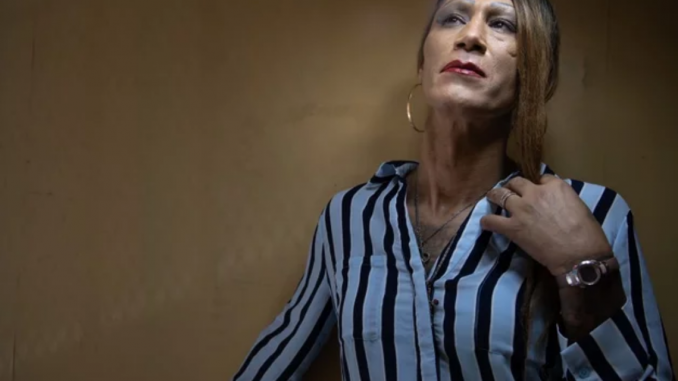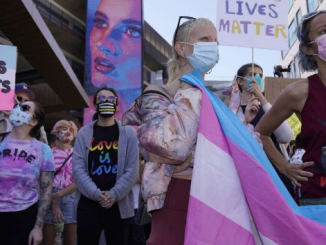
Kelly Blackwell longs to escape her life as a transgender woman in a California men’s prison, where she struggles every day to avoid being seen in her bra and panties and says she once faced discipline after fighting back when an inmate in her cell asked for oral sex.
After more than 30 years, and two decades since Blackwell began hormone therapy, her chance to leave arrived last fall when groundbreaking legislation gave transgender, intersex and nonbinary inmates the right, regardless of anatomy, to choose whether to be housed in a male or female prison.
The demand has been high, with 261 requests for transfers since SB 132 took effect Jan. 1, according to the California Department of Corrections and Rehabilitation. It’s the start of a hugely sensitive operation playing out in one of the largest prison systems in the country.
“I won’t be around predatory men and I won’t be around staff that frown upon trans women,” Blackwell, 53, said in a phone call from Mule Creek State Prison, east of Sacramento.
But more than two hours away, at the Central California Women’s Facility in Chowchilla, there’s fear. Inmates say guards have warned them that “men are coming” and to expect sexual violence.
“That if we think it’s bad now, be prepared for the worst. That it’s going to be off the hook, it’s going to be jumping,” Tomiekia Johnson, 41, said staffers have told her. “They say we’re going to need a facility that’s going to be like a maternity ward. They say we’re going to have an inmate program where inmates become nannies.”
Just over 1% of California’s prison population — or 1,129 inmates — have identified as nonbinary, intersex or transgender, according to the corrections department, populations that experience excessive violence in prison. A 2007 UC Irvine study that included interviews with 39 transgender inmates found that the rate of sexual assault is 13 times higher for transgender people, with 59% reporting experiencing such encounters.
So far, the prison system has transferred four inmates to the Chowchilla women’s prison, approved 21 gender-based housing requests and denied none. Of the 261 requests, all but six asked to be housed at a women’s facility.
Prisons spokeswoman Terry Thornton said in a statement that COVID-19 precautions have slowed the transfers and that officials could not estimate how long a transfer might take under normal circumstances, citing bed availability as a factor.
The Times spoke to more than a dozen inmates in women’s and men’s prisons to understand how the new law is playing out. Although advocates and inmates say the transfers have been received well, several claim that misinformation spread by prison staffers is stirring up transphobia and that more must be done to educate inmates.
Some prisoners are also concerned that inmates are making false claims about their gender identity in order to transfer to women’s prisons and say staffers have told them that this has slowed the process.
Thornton told The Times that the prison system had facilitated a town hall discussion with the Inmate Advisory Council at Chowchilla and with trans women at San Quentin State Prison. The meeting and ongoing discussions “have helped to dispel any fears,” she said, adding that allegations of staff misconduct are taken seriously and investigated.
When asked whether inmates in the men’s prisons trying to manipulate the transfer system has been a significant issue, Thornton said that “a person’s gender identity is self-reported and CDCR will evaluate any request submitted by an incarcerated person for gender-based housing.” She said that the prison system has requested several million dollars from the state to help implement the law.
In recent years, Connecticut and Massachusetts have passed similar legislation as the California law, which also gives inmates the right to be searched and addressed based on their gender identity. The laws help put states in line with the federal Prison Rape Elimination Act, or PREA, which prohibits housing decisions based solely on an inmate’s genitalia and requires agencies to consider on a case-by-case basis whether a placement would ensure an inmate’s health and safety. Despite PREA, advocates say that it’s rare for transgender inmates to be relocated.
The new California law follows other changes in the state’s treatment of transgender prisoners. In 2018, a law took effect removing obstacles for prisoners to change their gender and name. And in 2015, California became the first state to create policy for transgender inmates to apply for state-funded gender-affirming surgery. According to the prisons agency, from January 2015 through February 2021, 65 out of 205 requests for surgery were approved and nine were completed.
Under prison policy, transgender and intersex people — the latter being a term used to describe conditions in which a person is born with reproductive or sexual anatomy that doesn’t seem to fit the typical definitions of “female” or “male” — are placed, to the extent possible, in certain prisons to ensure they can receive certain medical and mental health treatment. With the new law, all inmates will be asked upon admission about their gender identity, their pronouns, whether they prefer the female or male search policy, and if they want to be housed in an institution that aligns with their gender identity, according to the corrections department.
Inmates can request transfers to their correctional counselor, which are then considered by a committee that includes the warden, custody, medical and mental health staffers, and a PREA compliance manager. Staffers review the inmate’s criminal record, health needs, custody level, sentence and safety concerns.
Michelle Calvin said inmates welcomed her with care packages when she transferred in February from Mule Creek to the Chowchilla prison. But there was also tension. Inmates in two rooms refused to have her as a roommate.
“There’s a lot of women here that accept me; there’s some that do not,” said Calvin, 50. “There’s going to be adversity everywhere and I understand that.”
Tyeasha Moore, housed a few doors down from Calvin, quickly warmed up to the newcomer. Calvin was “more than willing” to answer her many questions, including why she chose to come to the prison, and if other inmates would follow.
But Moore, 43, said that she has also heard staffers question inmates housed with Calvin, asking whether she has exposed herself, explained her sexual behavior to them or said things that made them uncomfortable. She said the questioning has fomented anxiety and false rumors that Calvin is in a relationship.
The prison system said that it has provided training to staffers statewide on working with transgender, intersex and nonbinary inmates, including information on safe housing, search procedures and pronoun usage. But advocates say it hasn’t been effective enough.
Mychal Concepcion, a transgender man in the Chowchilla women’s prison, said widespread panic about the transfers stems largely from staffers who ask inmates, “What are you going to do when the men get here?”
“The complaints from the cis [gender] women here are that these are men coming here and they’ve been traumatized by men and so they shouldn’t have to live with them,” said Concepcion, 51. “I have repeatedly said that they’re women, but their anger gets directed towards me.”
Johnson, the inmate who said staffers had told her to expect violence with the transfers, said that she has survived domestic violence from a man and that it would be triggering to live with transgender people who haven’t had gender-affirming surgery.
“I do think they should be safe, but it infringes on my right to be safe as well,” she said.
Tiffany Tooks, a transgender woman in the Chowchilla prison, has also been trying to address concerns. She transferred from Mule Creek in 2019 after having gender-affirming surgery.
“For me, it was everything,” she said, explaining how the inmates received her well after she opened up about her experiences from more than 20 years in prison — which included being raped and hearing inmates make sexually degrading comments when seeing her in the shower. “I feel it’s my duty to help the women that are coming here so they are not misunderstood.”
Tooks said that in early March, she participated in a meeting with the warden, prison staffers and other transgender inmates to address inmates in the men’s prison trying to transfer under false pretenses.
“The idea was how do we determine who really are transgender inmates coming into the prison system here and the fear of the women here who were afraid and still they are afraid that male inmates will infiltrate this prison system and cause problems,” she said.

Several transgender inmates at men’s prisons hold that the issue is prevalent.
A transgender woman at a men’s prison, who asked not to be identified for fear of retaliation, said that she knows at least five inmates who have applied to transfer under false pretenses and that staffers have asked her to help identify such inmates.
“They wanted me in a confidential setting to tell them who is transgender and who is not, so they can block some of these guys from going to the women’s prison,” she said. “I told him I don’t have a problem with it…. We feel they’re climbing our backs.”
Jasmine Jones, a legal assistant at the Transgender Gender-Variant & Intersex Justice Project, which provides supportive services to inmates, has been in touch with several dozen inmates in the women’s facilities with concerns about the transfers, explaining to them that she was raped several times in prison and attempted suicide four times.
She said that her story has resonated with many but that she’s still concerned about inmates posturing as nonbinary or transgender. Jones said the law should have first focused on those who have transitioned or are in the process of transitioning before allowing for others to transfer.
But Jen Orthwein, an attorney who represents transgender inmates and worked on the bill, said that not all inmates want or have access to hormone therapy or gender-affirming surgery, and that “any expression of femininity in a men’s prison places people in danger.”
At Mule Creek, Blackwell said that when she was approved to transfer she felt relief but also worry about entering a new environment.
She said it hurts to know that some are anxious about her coming over and asserted that transgender women have no plans to be predatory.
“They don’t want to do things like that because that’s been our life,” she said. “All we’re really hoping for is connection and compassion.”
*story by The Los Angeles Times


